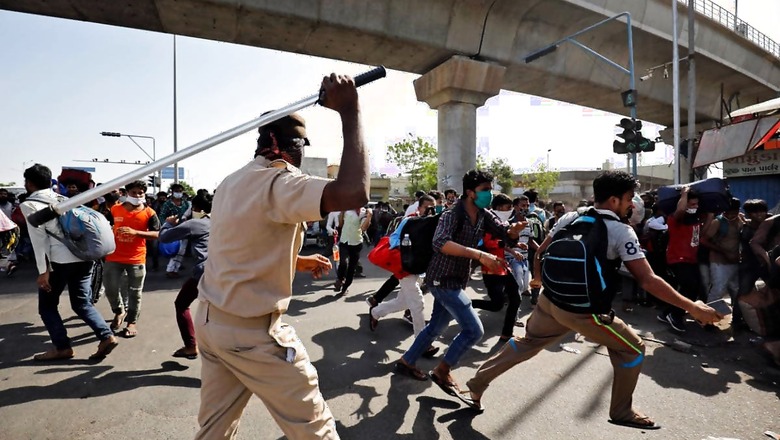
views
People around the world will be glad to see the back of 2020. It has been a year of disease, despair, economic pain, and social isolation. However, even as we look ahead and desire to put the past behind us, we must be conscious that the past year’s events have set a trajectory that will continue to have an influence in the coming year. Many significant issues confront India as we step into 2021, and in this piece, I will focus on the internal security challenge.
Over the years, national security has acquired a multi-layered dimension that goes beyond the application of military power and diplomacy. Internal conflicts could as easily be driven by armed terrorist groups seeking secession as by social exclusion, inequality, and economic distress. For ease of explanation, I will classify these challenges under two broad heads — traditional and non-traditional.
Let me first look at the traditional internal security challenges in which groups of armed insurgents/terrorists challenge the authority of the state in the Maoist-infested areas, some of the Northeastern states, and in Jammu and Kashmir. And there is a glimmer of hope in these areas.
The security situation concerning Left Wing Extremism has been steadily improving over the years. Although violence has not been completely eliminated, the Maoists have not achieved any significant success or expanded their areas of influence. According to data from the South Asian Terrorism Portal, the deaths of civilians and security forces in 2020 are the lowest in two decades.
In the Northeast, the Naga Accord, signed with much fanfare in Prime Minister Narendra Modi’s presence in 2015, is yet to be ironed out in detail. There is much bickering over the terms of the accord between the NSCN (IM), the largest insurgent group, and the government’s interlocutor. Despite these differences, there has been no resort to violence. Manipur is the ethnic tinderbox of the region, but here too, insurgent activity is almost negligible. In case we can find a just solution to the Naga Accord in 2021, it would have a calming effect on the entire region.
Jammu and Kashmir remains troubled. There are some positive indicators in that mass protests in Kashmir, anticipated by many after August 2019, have not broken out. The elections to the District Development Councils (DDC) have also passed off peacefully and could usher in much-awaited development at the local level. The polls also spell the restart of political activity in the Union Territory.
The problem in Jammu and Kashmir is the toxic mix of national and regional politics. The DDC election results have led to government claims of a victory for democracy even as the state remains under central rule. The People’s Alliance for Gupkar Declaration (PAGD), a grouping of regional parties, claims that their victory in the Kashmir region is a rejection by the people of the government’s decision of August 2019. This is also an extreme position. The truth, as always, lies somewhere in between.
Along with kickstarting political and development activity, the government must address the underlying causes of anger, alienation, and radicalisation in Kashmir. The DDC elections have also clearly exposed the Hindu-Muslim divide in how both communities have voted. A solution will need to find a middle ground between national and regional ideologies, politics, and aspirations of the people of both Jammu and Kashmir. Unless this is done, the unrest in Jammu and Kashmir could fester.
Let me now turn to non-traditional internal security challenges that could prove to be of greater concern in 2021. A nation will remain secure if its people are protected from risks and feel that the government is doing everything to ease their pain, and 2020 has been an excruciating year for almost all sections of the population. We must be conscious of the dangers of dissatisfaction among sections of the people spilling out into the streets.
Social unrest can result from perceived economic and social inequalities and be intensified by social media. All these factors are playing a role in our country. India has always had levels of income inequality that were among the highest in the world. The pandemic exposed this ugly reality when images of the rich and famous treating us to their aerobic routines were flashed alongside thousands of migrants walking home, some being sprayed with disinfectant as they squatted on the road.
An October International Monetary Fund report on the World Economic Outlook estimates that 40 million Indians could fall into “extreme poverty” due to the pandemic. On the other hand, the 2020 IIFL list of the rich in India showed that individuals with more than 1,000 crore wealth increased their cumulative wealth by 20%. You can’t complain about the rich taking advantage of the situation, but what is clear is that the poor in India have fallen further behind.
The pandemic has also increased authoritarianism around the world, and India is no exception. To be fair, faced with an unprecedented situation, the people looked towards the government to provide guidance and readily accepted the harsh measures imposed to control the spread of the virus. However, as time passed, there were also accusations that the government was taking the pandemic as an excuse to push its economic and political agenda and control dissent and protests on the grounds that large gatherings would lead to a virus breakout.
In this politically divided atmosphere, social media fuels further divisiveness. Stark positions are taken on Twitter, religious identity becomes the primary defining characteristic of individuals, and political affiliations are equated to nationalism. These narratives on social media could only fragment the multi-cultural nature of our society. Unfortunately, the dangers to national security posed by social media have not yet been recognized in India.
The hold of the virus, physically and psychologically, will weaken as we go through 2021. This could be accompanied by an expression of dissent by sections of the population who would want to equate a check on the virus with a return to pre-COVID economic and social status quo; a situation unlikely to happen in a hurry.
This is the time for all of us to tread with caution. Grievances among communities in India were traditionally about religion, identity, and ethnic rights. The new trigger is economic and social fears. The political class should steer clear of exacerbating the traditional grievances without addressing the more pressing problem of economic inequality and social harmony.
Read all the Latest News, Breaking News and Coronavirus News here


















Comments
0 comment